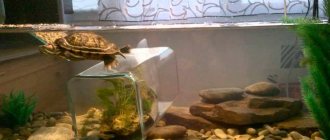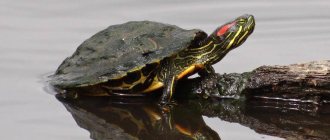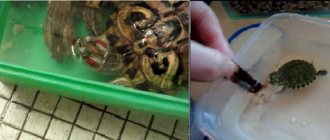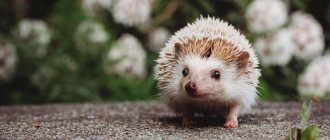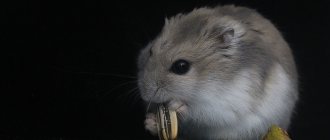Before getting an exotic pet, you need to learn as much as possible about the conditions under which it is kept. Errors in this regard can be very costly. Some animals are very picky about their diet and room temperature. You need to figure out what to feed the red-eared turtle if the choice falls on it, otherwise the reptile may develop serious illnesses.
In this article you will learn what you can feed this turtle.
Animal feed
It is best to build a diet based on animal food. The reptile's menu consists of 60% or more animal protein .
A turtle will happily eat any meat, but it is preferable to feed it lean varieties: beef, rabbit or poultry .
Attention! It’s a good idea to diversify your pet’s diet with fish, beetles and plants.
Meat
The aquarium red ear eats meat with pleasure, but how to feed it correctly and how many times a day so as not to harm it?
The basis of the diet is necessarily lean meat . Fatty lamb and pork will lead to digestive problems, illness and even death of the pet. In addition to the protein itself, the diet should contain by-products:
- heart;
- liver;
- stomachs.
You can occasionally feed your turtle small mice.
Important! A diet of only unprocessed meat is a direct path to vitamin A deficiency and rickets. You need to diversify the list of products, then your pet will be healthy.
What kind of fish is suitable for food?
What fish should you feed your red ear? As with meat, you need to choose lean varieties. First remove bones that can harm the turtle, as well as entrails and scales.
In addition, before serving, it is recommended to dip the fish in boiling water for a couple of minutes so that the thiaminase enzyme coagulates.
A cocktail made from sea creatures would be a good addition to your diet , but you shouldn’t give it often.
Attention! The redfish will not get along in an aquarium with fish and snails - this is its natural food supply.
Insects
What do red-eared turtles eat besides food? You will be surprised - insects! In summer they add to the menu:
- grasshoppers;
- caterpillars;
- bloodworm;
- mealworm;
- gammarus;
- daphnia (but in this case it is better to turn off the filter for a while).
Other animal food options
You should not feed your turtle caught cockroaches or spiders.
Insects can be “stuffed” with toxic substances, which will certainly harm your pet.
What should you not feed your red-eared turtle?
Despite the fact that this armored reptile is considered an omnivore, there is a certain list of foods that are strictly contraindicated for these animals. The list of foods harmful to turtles includes the following components:
- poisonous land plants and algae (Elodia, Ambulia, Legendandra);
- plant and animal products containing large amounts of oscalates, phosphorus, purines (tomatoes, cabbage, raw liver, fatty meat, etc.);
- poisonous and poisonous insects;
- locusts and grasshoppers with serrated stalks;
- fatty meat and fish;
- bread, potatoes, etc.
Many of the above foods contain substances that can lead to the development of diseases such as gout, goiter and iodine deficiency in the turtle. The seemingly beneficial phosphorus interferes with the absorption of calcium, which also applies to oscalates.
Plant food
The diet of an adult turtle should be dominated by plant components . The older she is, the more vegetarian dishes are on the menu.
Grass
Little Reds eat their coltsfoot with gusto. Also great for:
- leaves of plantain, clover, dandelions;
- sprouted oats and barley.
Aquarium plants
Seaweed is a good addition to the menu. Duckweed, watercress and any plants from natural bodies of water are suitable
Vegetables
Turtles love kibble:
- bell peppers;
- zucchini;
- eggplant;
- cucumbers;
- tomatoes;
- carrots;
- beets;
- pumpkins.
Mushrooms
Once a week, champignons, russula or boletus , cut into small pieces, are added to the regular diet.
How to handle a pet
Like all turtles, the swamp species is quite smart
The pet quickly gets used to the person, but you still need to be careful when communicating, they are insidious, and if they are in a bad mood they can bite, and it can even hurt! The turtle understands perfectly well that the person has come to feed it, and will quickly rush to land to receive the coveted portion. When feeding, such individuals are aggressive, and it is better to give pieces carefully, without exposing your hands too much.
When feeding, such individuals are aggressive, and it is better to give pieces carefully, without exposing your hands too much.
The turtle understands perfectly well that the person has come to feed it, and will quickly rush to land to receive the coveted portion. When feeding, such individuals are aggressive, and it is better to give pieces carefully, without exposing your hands too much.
You must handle your pet very carefully, and it is better not to touch him at all when the turtle is not in a good mood. She will show her aggressive attitude by snorting and hissing. If you ignore the warning, the turtle will make sudden jumps
If you ignore the warning, the turtle will make sudden jumps.
such a pet is not a toy for children; they pose a mutual danger to each other. Immediately warn your child that such a pet cannot be played with, picked up, and can only be stroked under the supervision of an adult.
Swamp turtles are very aggressive towards each other, they fight and gnaw off their tails, so only one turtle is allowed to be kept. Other species are food for them, do not add a turtle to fish, and vice versa.
Artificial feed
Pet stores generously offer a wide variety of food for turtles , but such mixtures do not cover the reptile’s need for proteins and microelements.
Homemade food
If store-bought food is not suitable for your turtle, you can prepare the food yourself.
Take:
- 50 g cabbage;
- 70 g carrots;
- 150 g lean fish;
- 50 g apples;
- 100 g squid meat.
The products are passed through a meat grinder or crushed with a blender . Add 2 eggs, gelatin (1 tablespoon per 150 ml of water) and 150 ml of milk to the mixture. Mix everything thoroughly and store in the refrigerator for no more than a week.
This amount of food is enough for about 10 servings for one small turtle. Before serving, food is cut into portions.
Is it possible to give turtles dog/cat food?
Although turtles eat commercial cat and dog food with great pleasure, such a diet does not benefit them.
Such mixtures do not contain the microelements necessary for reptiles, and abuse of such a diet will lead to serious health problems for the turtle .
How often and at what time should you feed your turtles?
A difficult question that cannot be answered unequivocally. Much depends on the age and size of the animal, and on the food you feed.
For young animals up to 1 year old, plant foods and artificial feed are suitable. Feeding should be daily.
From 1 year and older you can feed every 1-2 days. If the turtle prefers plant foods, it is recommended to feed it daily. The amount of food also depends on the age of the turtle.
Proper feeding is the main condition for the normal development of red-eared turtles. Every owner should feel his pet, choose the right food and give him what he likes and what is healthy.
Vitamin and mineral complexes
Turtles need calcium to form their shell. fill the need for microelements with the help of bone meal - it is mixed into the food.
A pinch is enough for young redears; for older ones, a teaspoon is “stretched” for a week.
In addition, special vitamins for turtles are added in accordance with the instructions, but the shelf life of such food is limited.
Big turtle loves natural
So, the preferred representatives of the ichthyofauna for a turtle’s lunch include the following, namely:
- bream;
- European hake;
- whiting;
- zander;
- mullet;
- pike;
- flounder.
The fish should not be cut up as the turtle usually swallows the prey whole. She needs all those beneficial substances contained in the skeletal system of fish. Without them, your pet is likely to have problems with the strength properties of the shell and skeleton as a whole.
You also need to remember that raw fish contains thiaminase, so before giving the turtle raw fish, you need to keep it in hot water for a couple of minutes.
You can also give your turtle mixed seafood, such as:
- mussels;
- oysters;
- squid and octopus;
- all types of shrimp.
These foods can be considered a treat for the turtle. However, it is not recommended to use them as the main food.
Diet
How often should you feed your red-eared slider? Young and actively growing individuals are fed every day. Up to a year, protein must be present in the menu (60-70% of the total diet). Upon reaching the age of 2-3 years, growth slows down. The body's energy needs decrease. For an adult turtle, it is enough to eat a large meal once every two to three days. The amount of protein consumed is reduced to 40%. On fasting days, only small quantities of green food are offered.
Aquarium
Ideally, 150 or more liters, but for starters, 10 liters will be enough. However, prepare for the fact that your pet will grow quickly, gaining 3-4 cm in height every year until it reaches its normal size (20-30 cm depending on gender and subspecies). They also need to exercise a lot to avoid becoming obese. Yes, turtles can also suffer from this disease. Therefore, the minimum dimensions of the aquarium should be such that its width is not less than three shell lengths, and its length is not less than six lengths.
You need to pour enough water so that the turtle can stick out its muzzle while standing on its hind legs. If the aquarium is deeper, then you can place a stone or driftwood in it for this purpose.
It is strictly forbidden to use small stones as soil! Being carried away by getting food, small turtles (and sometimes adults) can accidentally swallow a pebble, which will cause intestinal obstruction and, as a result, the death of the animal. Remember that some aquatic plants (Elodea, Lagenandra, Ambulia) are poisonous to reptiles.
Banned
First of all, I would like to protect readers from the mistakes made by many inexperienced owners of exotic pets.
The harmful ones include the following, namely:
- poisonous plants;
- spinach, peas, rhubarb;
- tomatoes;
- fatty fish;
- radish;
- asparagus;
- citrus fruit;
- nuts;
- mushrooms.
All of these diet ingredients are harmful to the turtle. Spinach and peas, for example, contain a large amount of oxalates, which can lead to the development of some dangerous diseases in your pet.
Tomatoes interfere with the absorption of calcium, resulting in a negative impact on the formation of bone structure in young turtles. And citrus fruits are generally not intended for turtle nutrition in any variation.
Getting ready to purchase
About 80 percent of people who started reading this article will think - what is the purpose of preparing, bought an aquarium and went after a turtle. It couldn't be simpler. But it turns out that everything is not so simple
And we will emphasize the importance of preparing for buying a turtle using the example of a specific family from the city of Moscow, into whose life a small green cute thing named Rafa burst into
The appearance of the animal caused unimaginable delight, and, naturally, it was necessary to urgently solve the turtle’s housing problem. The first aquaterrarium was purchased and furnished on the same day, and Rafa rushed to explore the new home. Why the first? Some nuances should have been known about reptiles, as it turned out a little later.
Not a single seller of terrariums on the market told buyers that after 2-3 years a 30-liter container will no longer be enough for a turtle. After all, animals grow to the size of a good plate of soup in the size of a shell.
No one said that red-eared turtles are not hamsters, they live 2-3 years and the owner is allowed to choose a new pet. In captivity, red-eared turtles live up to 50 years. And you should approach the question responsibly: are you ready to take care of this pet for half a century, or is it not for you.
Well, and the most interesting thing is that when asked about feeding, the sellers named different types of food, but forgot to mention the main point - if you feed the animal with meat, the turtle will develop the habit of biting. And with a high degree of probability, by the age of 5 the creature will become simply dangerous to pick up and try to play with it.
Still have the desire to buy such a pet? Then let's figure out what to feed the turtle.
Lamps
An ultraviolet lamp is necessary for the turtle to produce vitamin D3, which is involved in the absorption of calcium. In nature, sunlight contains enough ultraviolet radiation, but at home you need special lamps. Household UV sources are not suitable for these purposes, because they are difficult to provide the required wavelength. The most common terrarium (aquarium) lighting options are Repti Glo 5 and 8 lamps. Place these lamps at a distance of no closer than 40 cm, as they can cause burns.
A regular incandescent lamp (from 40 to 60 W), the light spectrum of which includes infrared rays, is needed by turtles to digest food. Various metabolic processes in cold-blooded animals, which include reptiles, occur only at a certain ambient temperature, which is ensured by lamps. A decrease in temperature entails a slowdown in metabolism and hibernation.
Lighting a terrarium for a red-eared turtle
Caring for your turtle
The first thing you should pay attention to when purchasing a pet is its appearance and size. A turtle that is under 5 cm in size at the time of purchase will be very difficult to raise. At this age, small individuals are susceptible to various infections and diseases.
This is how natural selection takes place. Therefore, a turtle 5–7 cm in size will be the best choice when purchasing
At this age, small individuals are susceptible to various infections and diseases. This is how natural selection takes place. Therefore, a turtle 5–7 cm in size will be the best choice when purchasing.
You should also carefully examine the color of the shell. The claws and tail must be intact. The skin looks healthy and the eyes shine. After the pet is in the aquarium, watch how it swims. A healthy turtle should swim smoothly, without leaning in different directions.
Healthy turtle
Features of treatment
After purchasing a pet and moving it into an aquarium, it may go through an adaptation period. Typically it will take 2 to 5 days. At this time, the animal becomes a little inhibited, or, conversely, very active. There is no need to panic and pick up the animal. Give him peace and time to adapt to new conditions. After a while, the turtle will get used to the new environment and become calmer.
When trying to pick up a turtle, do it very carefully and always with both hands. Not all representatives are willing to make contact. Some may flounder, hiss, and defecate in fear. The shell becomes slippery in water; keep this fact in mind when removing your pet from the aquarium.
After you hold the turtle in your hands, be sure to wash them with soap. Despite being kept clean, turtles are often carriers of salmonellosis. To avoid the spread of infection, you must always monitor the condition of the aquarium and the quality of the food.
Cleaning the shell
Since green algae in an aquarium is a source of infection, it is important to regularly clean not only the container, but also the turtle’s shell. They cannot do this themselves. During the decomposition process, algae also fall under the surface of the shell, and as they decompose, they harm the shell
During the decomposition process, algae also fall under the surface of the shell, and as they decompose, they harm the shell.
You will get used to the fact that once every 3-5 days you need to take the turtle out of the water and wipe its shell with a clean cloth, a special soft napkin, or gently brush it with a toothbrush. During the process, you should try to remove all small particles of algae and other dirt.
Cleaning the shell with a toothbrush
Some unscrupulous owners try to make the turtle's shell beautiful and lubricate it with various oils or creams to add shine. This is strictly prohibited, as it harms the skin and interferes with the healthy “breathing of the body” of the pet.


